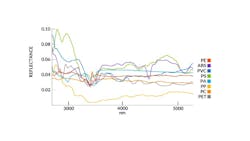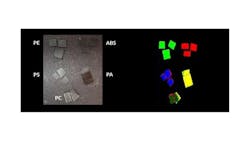Using MWIR Hyperspectral Imaging to Battle Black Plastic Pollution
Plastics are an essential part of everyday life, with worldwide production surpassing 380 million metric tons each year. Among the different types of plastics, black plastic represents a significant portion of this output due to its functionality and visual appeal, making it popular in consumer products. Black plastics are widely used in high-demand industries like automotive manufacturing for their durability and wear resistance. In electronics, they protect delicate components, such as casings and parts, and preserve freshness by blocking light and oxygen in food packaging.
Studies suggest that black plastic accounts for approximately 15% of the plastic waste stream. However, the current recycling rate for black plastic is low. Why? Because traditional sorting technologies used in recycling facilities to sort plastics cannot distinguish the black color, black plastics are often misidentified, leading to low recycling rates, which poses a growing environmental problem.
Stricter regulations are being implemented across various regions, requiring manufacturers to include a specific percentage of recycled plastics in their new products. For instance, the European Union's End-of-Life Vehicle (ELV) Directive mandates that when a vehicle is no longer in use, at least 85% of its weight should be reused or recycled. This means that materials can be reprocessed into new products or parts can be reused. Additionally, at least 95% of the vehicle must be reused or recovered, which includes processes like generating energy from materials that cannot be recycled. Additionally, the EU’s Packaging and Packaging Waste Directive requires that 50% of plastic packaging be recycled by 2025 and 55% by 2030. Effective methods for sorting black plastics are needed to meet the targets.
How the Plastic Recycling Process Works
Plastic recycling is a multi-step process. It typically begins with collecting and separating plastics from general waste streams. Once separated, the plastics are sent through shredding machines that break them into smaller flakes, making them easier to process. These flakes are then washed to remove dirt, labels, and other contaminants. After that, optical sorting systems sort plastic flakes by polymer type to ensure that each batch is composed of a uniform plastic resin, which is crucial for producing high-quality recycled materials.
Related: Eagle Vizion's Machine Vision System Inspects Shredded Plastic Particles
Optical sorters typically rely on near-infrared (NIR) imaging spectroscopy to identify plastic types based on their unique spectral signatures. For most plastics, this system works seamlessly. However, black plastics, which are typically colored with carbon black pigments, absorb almost all light in the visible and infrared spectrum instead of reflecting it, rendering them effectively invisible to NIR sensors. As a result, black plastic flakes are often misclassified or discarded as waste, reducing recycling rates, and sending valuable material to landfills or incinerators.
Alternatively, gravity sorting—where materials are separated based on density in water or other fluids—has been used as a fallback option. While it can help separate black plastics, the process is resource-intensive, requiring significant amounts of water and chemicals. Additionally, gravity sorting is less precise, resulting in lower purity levels in the recycled plastics.
Plastics that are not pure are often downcycled or converted into alternative products like oil, while higher-purity recycled plastics are more suitable for creating new, high-quality materials.
Related: Hyperspectral Imaging Continues Industrial Growth
Mid-wave infrared (MWIR) hyperspectral imaging (HSI) enables precise identification and sorting of black plastics, providing a solution to address the limitations of the traditional NIR and gravity-based systems.
Advantages of and Challenges of Hyperspectral Imaging in Sorting Plastic
Hyperspectral imaging is an advanced technology that merges spectroscopy with imaging capabilities. Hyperspectral cameras capture and analyze the unique spectral signatures of different materials, allowing for accurate identification and separation based on their chemical composition rather than visual characteristics such as size, shape, or color.
HSI enables precise differentiation of materials that may appear similar to the naked eye, such as different types of plastic. Additionally, HSI supports real-time processing, allowing for rapid, accurate, and automated sorting. This makes it a powerful and widely adopted solution for industrial waste management, particularly in sorting plastics.
Related: Thermal Ranging Technique Delivers Detailed Images
Hyperspectral cameras scan materials on conveyor belts at high speed, analyze their spectral data, and classify them using advanced algorithms. Sorting systems then automatically separate identified plastics through mechanisms such as air nozzles.
Overcoming Black Plastic Sorting with MWIR Hyperspectral Imaging
Mid-wave infrared (MWIR) hyperspectral imaging is proving to be a highly effective solution for the challenge of sorting black plastics, a task that NIR imaging has long struggled with. While NIR hyperspectral imaging operates in the spectral range of approximately 900 to 2500 nanometers (nm), MWIR HSI expands the scope by capturing highly detailed spectral data across the 3 to 5 micrometer (µm) range.
Related: Spectroscopy Uncovers the Hidden in Art and Archaeology
In the MWIR range, different plastic types exhibit distinct spectral features due to their molecular composition (See Figure 3). Consequently, when using hyperspectral imaging in the MWIR range, it's possible to differentiate between different types of plastic, regardless of their color, including the most challenging black plastic.
Real-World Applications and Industry Benefits
Industries relying heavily on black plastic polymers, such as automotive, electronics, and packaging, benefit significantly from this advanced technology. For example, black plastic is widely used in dashboards, bumpers, and trim components in the automotive sector. By effectively sorting these materials, MWIR HSI technology can help automotive manufacturers achieve their recycling goals and reduce the environmental impact of vehicle production.
In the electronics industry, black plastic casings are common in everything from smartphones to home appliances. Using MWIR hyperspectral imaging, recyclers can effectively sort black plastic from discarded electronics, assisting manufacturers in meeting increasingly strict e-waste regulations.
Related: c-Trace Develops Mobile Inspection System for Organic Waste Disposal
The food packaging industry also stands to benefit. Black plastic trays are commonly used for ready-to-eat meals and other food products. By enabling more effective sorting of these trays, MWIR HSI helps reduce the amount of food packaging waste that ends up in landfills.
Environmental and Economic Benefits of Recycling Black Plastics
The ability to sort and recycle black plastic brings significant environmental and economic benefits. Recycling prevents black plastics from being sent to landfills or incinerators, reducing environmental pollution and conserving valuable resources. It also helps to close the loop on plastic waste, supporting the transition to a circular economy where materials are reused rather than discarded.
Economically, recycling black plastic offers cost savings for manufacturers. The ability to reuse black plastic in new products reduces the need for virgin materials, lowering production costs. Additionally, companies can avoid penalties for failing to comply with recycling regulations, making MWIR HSI a financially viable option for those aiming to remain competitive in an increasingly environmentally conscious market.
Alignment with Global Sustainability Goals
Integrating MWIR HSI into recycling processes benefits industries and aligns with broader global sustainability goals. The United Nations' Sustainable Development Goals (SDGs) emphasize reducing waste and increasing resource efficiency. MWIR HSI helps industries comply with these goals and regulations by enabling the efficient recycling of black plastics.
Related: Manufacturers Address Non-Visible Imaging Lens Requirements
As more countries implement extended producer responsibility (EPR) regulations, which require manufacturers to manage their products' entire lifecycle, including disposal and recycling, MWIR HSI technology will become an essential tool for meeting regulatory requirements. Adopting this technology can provide companies with a competitive advantage in regions such as Europe, where these regulations are already established.
A New Era for Black Plastic Recycling Using MWIR Hyperspectral Imaging
The introduction of MWIR hyperspectral imaging technology represents a significant advancement in recycling black plastic. This innovative technology overcomes the limitations of traditional NIR systems and non-optical sorting methods. It enables efficient sorting of black plastic, contributing to reduced landfill waste, supporting circular economy initiatives, and aligning with global sustainability goals.
About the Author

Minna Törmälä
Minna Törmälä, PhD, is the global marketing manager for Specim, Spectral Imaging Oy Ltd (Oulu, Finland), which specializes in hyperspectral imaging.



